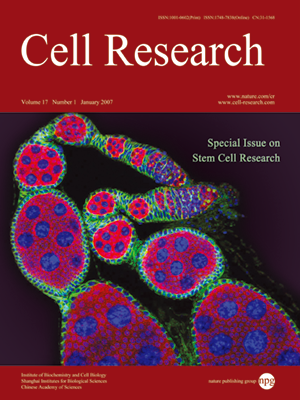
Volume 17, No 1, Jan 2007
ISSN: 1001-0602
EISSN: 1748-7838 2018
impact factor 17.848*
(Clarivate Analytics, 2019)
Volume 17 Issue 1, January 2007: 80-87
ORIGINAL ARTICLES
Establishment of customized mouse stem cell lines by sequential nuclear transfer
Chunli Zhao1, 2, *, Ruqiang Yao1, 4,*, Jie Hao1, 4, Chenhui Ding1, 3, Yong Fan2, Xiangpeng Dai1, 4, Wei Li1, 4, Tang Hai1, 4, Zichuan Liu1, 2, Yang Yu1, 2, Yingying Wang1, 3, 4, Xiaojun Hou1, 4, Weizhi Ji2, 3, Qi Zhou1, 2, Alice Jouneau1, 2, 5, Fanyi Zeng2, 6, Liu Wang1, 2
1State Key Laboratory of Reproductive Biology, 2Joint laboratory of biology of embryonic cells of mammalians (LABIOCEM), Institute
of Zoology, Chinese Academy of Sciences, Beijing 100080, China; 3Department of Reproduction and Development, Kunming Institute
of Zoology & Kunming Primate Research Center, Chinese Academy of Sciences, Kunming 650223, China; 4Graduate University of
Chinese Academy of Sciences, Beijing 100049, China; 5INRA, UMR 1198; ENVA; CNRS, FRE 2857, Biologie du Développement et
Reproduction, Jouy en Josas, F-78350, France ; 6Institute of Medical Genetics, Shanghai Jiao Tong University School of Medicine,
Shanghai 200040, China
Correspondence: Liu Wang and Fanyi Zeng(qzhou@ioz.ac.cn; zengfy@shsmu.edu.cn)
Therapeutic cloning, whereby embryonic stem cells (ESCs) are derived from nuclear transfer (NT) embryos, may play a major role in the new era of regenerative medicine. In this study we established forty nuclear transfer-ESC (NTESC) lines that were derived from NT embryos of different donor cell types or passages. We found that NT-ESCs were capable of forming embryoid bodies. In addition, NT-ESCs expressed pluripotency stem cell markers in vitro and could differentiate into embryonic tissues in vivo. NT embryos from early passage R1 donor cells were able to form full term developed pups, whereas those from late passage R1 ES donor cells lost the potential for reprogramming that is essential for live birth. We subsequently established sequential NT-R1-ESC lines that were developed from NT blastocyst of late passage R1 ESC donors. However, these NT-R1-ESC lines, when used as nuclear transfer donors at their early passages, failed to result in live pups. This indicates that the therapeutic cloning process using sequential NT-ESCs may not rescue the developmental deficiencies that resided in previous donor generations.
Cell Research advance online publication 9 January 2007; doi: 10.1038/sj.cr.7310139
FULL TEXT | PDF
Browse 1978


